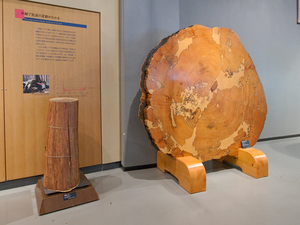Nagoya City Science Museum
TOP > Exhibition Guide > Floor Map> The oldest Japanese cypress (hinoki)
The oldest Japanese cypress (hinoki)



Purpose of Exhibition
This exhibit is designed to introduce you to the global environment history through the tree rings.
Additional Knowledge
This tree trunk slice is from a Japanese cypress called "Kiso hinoki", which was located at Kashimo-mura, Ena-gun, Gifu-ken, and was cut down by the Tsukechi District Forest Office in 1954. The after-cutdown research on the tree trunk slice verified 925 annual growth rings. The "Koso hinoki" was determined to be 950 years old by adding 25 years, presumed age of the tree roots left behind at the tree location. It means that the "Koso hinoki" sprouted out in 1004. The rings that you see in this tree trunk slice are the very register of the tree's 950-year history.Incidentally, is it possible to learn about the global environment history from the rings of the "Koso hinoki"? The tree's ring width is indicative of the tree's growth speed. So anyone could imagine that it would vary with changes in temperature. Understandably, trees grow fast in warm climates, thus making their rings wide, and slowly in cold climates to have narrow rings. In this relation, a research was launched to determine the past temperature variations in the mountain region of central Japan. The results of the research are shown in the graph on the right, which clarifies the cold climates (in the Little Ice Age) approximately from 1200 through the first half of the 1800s and the warm climates thereafter.In fact, the tree's ring width depends on not only climates but also other factors. It is, therefore, not easy to draw a conclusion on the past temperature variations. The ring width is also determined by rainfalls, carbon dioxide concentrations, insolation levels, etc. Furthermore, in Japan where it is hot and humid, the ring width is more influenced by competition with adjacent trees than climate-related factors. Data compilation is, therefore, based on the "tree ring average" of numerous trees. It must also be taken into consideration that the ring width diminishes with the tree's aging. Another thing to keep in mind is that sufficient data on the past are unobtainable if researches are conducted only on living trees. Therefore, it is essential to figure in the annual growth rings of nurse logs.To sum up the matter, the past temperature variations are determined by eliminating all conceivable factors influencing the rings of trees (of course, except temperatures).
Science allows us to decode the global environment-related historical messages hidden in the rings of trees.
Article by Shoji Nishimoto, curator
